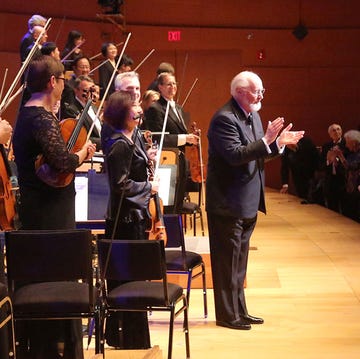Catalina’s built environment is thick with artisan tile—on steps, façades, benches, walls, fountains, and, of course, the ornate Catalina Casino. For Sonia Romero, whose work is currently on display at the Catalina Museum for Art & History, bespoke ceramic-tile mosaic has also been an essential vessel for her public-art practice across Los Angeles. The material is central to her expansive LA Metro station art commissions, including at Westlake/MacArthur Park and Boyle Heights’ Mariachi Plaza.
From Los Angeles to Catalina: The Art of Sonia Romero, which is open through March, displays a combination of paintings and mixed-media works on canvas as well as several serial prints on paper. The exhibition is a pared-down version of Romero’s 20-year retrospective (exhibited at Loyola Marymount University in fall 2023), combined with brand-new work about the history of Avalon, the island’s only city.
Sheila Bergman, the museum’s executive director, had been eager to find programming that would attract Catalina residents. “We wanted to have locals claim the museum as their cultural space, not just a space for tourists.” Romero understands the island as a microcosm of everything Angelenos navigate in the mainland metropolis—but with 4,000 residents, not some 4 million. Avalon’s small, working-class population exists to serve the more than 1 million tourists who travel to the island every year for snorkeling, parasailing, and bird-watching.
Even before stepping off the ferry at the busy end of Avalon Harbor, one registers the same convergences that define daily life in Southern California—wilderness and development, tourism and labor, ecology and commerce, history and fantasy, beaches and business. As Romero notes, “You can’t talk about it without touching on the film industry, maritime culture, nature preservation, and the way island ecology mirrors L.A.’s own resource scarcity and evolving diversity.”
In 2024, 44-year-old Romero led a series of printmaking workshops for the local community. Reminded of her middle school field trip to Catalina and memories from other past visits, she began researching the island using the museum’s permanent collections and archives. By the time her solo exhibition was set to open this May, it was perhaps inevitable that there would be a new Catalina picture.
In the vibrant painting The Tourist (Avalon) (2025), a modern woman with vintage sartorial glamour leans against the harbor’s famous seawall path to the casino, admiring the view. “When I was a teenager, I was obsessed with 1940s swing dancing,” Romero recalls. “The casino in Avalon has a beautiful vintage ballroom, and I built so many fantasies about going there to dance.” To create the colorful scene, Romero collaged her own linoleum-cut prints on delicate Japanese paper into the acrylic and oil paint. “I’ve been trying to combine printmaking and painting forever,” she says. “I think it’s finally working.”
Romero chose a friend to model the figure in the painting, a striking woman of Mexican American and Chinese heritage who embodies Catalina’s and Los Angeles’s demographic texture. As portrayed in the painting, the woman leans against a tiled wall decorated with native species like garibaldi fish, bison, the Catalina Island fox, and the ubiquitous prickly pear that arrived on the island with Mexican immigration and has stayed to flourish. A tattooed flying fish spreads its wings across her sternum. “I’m obsessed with flying fish,” Romero says of the winged creatures who enliven the island’s waters and are thought to be good luck. “They represent transcendence.”
Romero always kept her robust public art and popular studio practice separate—large civic commissions on one side, fine-art studio work on the other. Her plans to pursue the history of Catalina in another exhibition (the opening date is yet to be announced) give her a chance to collapse that distinction. “There’s a weird, awkward leap when you bring fine art into public space,” she says. “I used to swim against that current, but now I think I had it backwards.” Romero is currently distilling images informed by ongoing research, community listening, and iconic imagery; the finished series will be five paintings that together form one long mural.
Inspired by the aesthetic conventions of the island’s famous painted-tile trade, the new paintings will each tackle a different theme: tourism; the Mexican American labor force that keeps Catalina running; boating and yacht culture; the kids’ camp and field-trip culture; and a fifth topic still open, potentially something like the island’s flora and fauna or its conservancy lands, water scarcity, or the pressures of cruise-ship arrivals, with their massive and sudden population-doubling influx of tourist chaos. So far, the paintings are lush, their messages clear. “Catalina itself keeps opening up,” she says. In fact, this exhibition will be far from the final iteration of the island’s offering of rediscovered inspiration.
Only one of the five new works is fully underway, so Romero will be returning regularly to the island, with her family, building knowledge the way you build trust—slowly, across seasons, and even years. When it’s ready, the five-panel Catalina cycle will return to Avalon as a singular exhibition at the museum. “Catalina offers vivid nature, layered history, and rich iconography,” says Romero. “It’s a gift for someone like me, who builds meaning into every single element.”•
FROM LOS ANGELES TO CATALINA: THE ART OF SONIA ROMERO
May 3, 2025—March 15, 2026
Catalina Museum for Art & History
217 Metropole Ave., Avalon
Shana Nys Dambrot is an art critic, a curator, and an author based in downtown Los Angeles. Formerly the arts editor at LA Weekly, now a cofounder of 13ThingsLA, she is the recipient of the Rabkin Prize, the Mozaik Future Art Writers Award, and the Los Angeles Press Club’s Critic of the Year award (twice). Her novella, Zen Psychosis, was published in 2020.















